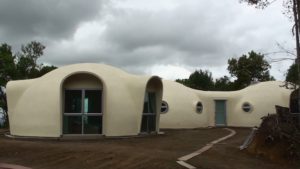
Reader Question: My wife and I are considering building a dome home on an acre we own free and clear. The estimated cost of construction would be around $100,000. All the other homes near us are aging double-wide (1990’s) manufactured homes. My research indicates we would be the only one within 100 miles. We are retired and don’t ever plan to sell this home. Would a bank lend against it for a potential buyer down the road (presumably after we are gone)? What kind of retention of value do dome homes have in their history? The cost of building the dome and buying a new double-wide is the same, so why not do it?
Monty’s Answer: Over the past few decades, I can only recall having sold one dome home out of the many thousands of home sales in our company, so my personal experience is limited. I have followed geodesic domes from the sidelines over the years. My sources were construction periodicals, websites and consumer reviews. Here are some background observations before answering your questions.
We have sold many other types of housing that were unusual. Converted churches, barns, silos, commercial buildings, underground homes and more. Residences built from alternative materials like sheet metal, telephone poles and railroad ties, even mud bricks pop-up occasionally around the country. My opinion is that at the time of these sales, many, but not all, of the enthusiasts if they had the chance to go back and do it over again, would not repeat the experience. Inexpensive materials often drive unusual design. According to anecdotal comments on Internet sites, unusual design and materials can present unintended consequences in future repairs and maintenance.
The real estate market punishes home design and construction material that is out of the mainstream with a limited selection in the resale market. For example, will your dome home fit the needs of those few interested buyers?
There are many links to “dome home” information with an Internet search. They come in all sizes. Some are built from kits while others are custom concrete construction. They are said to be more popular in areas where earthquakes, tornadoes, and hurricanes are present because they are deemed to have superior resistance. The promoters also mention energy savings as a feature adding value.
Do you have children? Relatives? What charities would leave your assets to when your time comes? While you don’t plan to sell, what if your health changes and you or your wife can no longer live in the home? Will it be easy to dispose of your dome home?
The answers to your questions
Some, but not all, lenders would lend on a dome home. Those that would lend may require larger down payments than they would on a more traditional product. If this is true, it further limits the market. Consider becoming a secret shopper for a day and attempt to borrow the money. Test area lender responses for yourself.
In terms of retention of value, the product scarcity, construction material differences, quality of construction, and other variables present a difficult question to answer. I am not aware of any independent source with viable comparable sales data by location.
If you are intent on building a dome home, the reason not to build is that you are considering the wrong location. I am not suggesting that you not build a dome home. As long as your home meets local building ordinances and code requirements, you can do what you desire. Your risk is that you will lose money. This is just an opinion that cannot be proven because there will be no comparison control project.
My advice is that if you go ahead and build a dome, you can improve your chances of protecting your asset if you:
1. Build it on a site that has a private, scenic view. A lake, a river, a mountain, a woodlot, or a rolling prairie that would appeal to more people.
2. Whatever you build, build quality. Use well-designed products for the intended purpose. While satisfying your dreams, think about the next user. If you buy a kit, compare the quality of components and the contractors. Look for longevity. Look at earlier models that are 30 years old to see how well they have stood up.
3. There is another old saying in real estate besides “don’t be the best house in the neighborhood,” it is “location, location, and location.”


